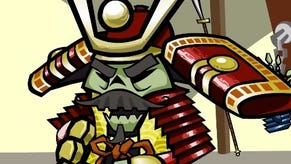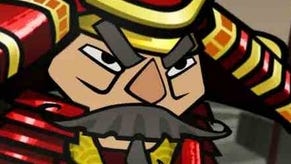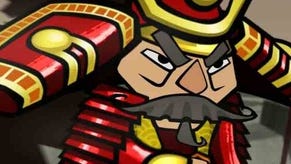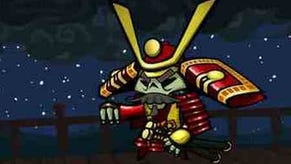Skulls of the Shogun Preview: Turn-Based Terror
Hands on with the spooky heir to Advance Wars.
Firstly, it's really pretty.
"When I saw Wind Waker back in the early 2000s, I was just blown away," says Jake Kazdal, the creative director and art director at 17-Bit, and one of just a handful of men behind Skulls of the Shogun. "I was working in Japan and I was just stunned by how awesome Wind Waker looked. I asked people what that look was, and they said, 'Oh, it's based on this old children's anime from the '60s.'
"Back before the limited frame anime, it was full-blown Disney quality animation for children, and they'd do these huge summer movies for the kids. They were basically adventure movies for little boys: Aladdin, Treasure Island, that sort of thing. That's what Wind Waker totally took its look from. When I started Skulls, I wanted to get better at that look, so I did a ton of studies, tore it apart, and just had to have it in the game. Simple shapes, bright colours, simple values."
Skulls of the Shogun is a turn-based strategy game in the spirit of Advance Wars, then, but there are no tiled levels or screen-filling stat displays getting between you and the art (although tiles can sometimes create a style of their own, of course).
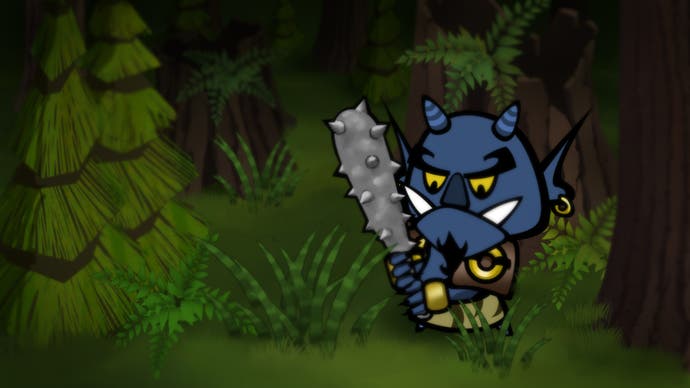
Instead there's just a gaggle of skeletal warriors clad in wonderful angular Samurai armour, clashing smartly as the seasons change from spring to summer, and from autumn to winter. Cherry blossom flutters and enemies explode in puffs of cartoon smoke while the foliage slowly turns a rusty brown and waves pound the cliffs that line the bottom of the maps, sending rhythmic bursts of spray onto the battlefield. It's a Halloween cartoon special of a game: a game that exudes a calm stylish poise in screenshots, and vents barely contained comic energy in motion.
It's clever, as well. It's clever in the infrastructure, which employs campaign cloud saves and asynchronous multiplayer to allow you to take your progress from XBLA to PC to Windows phones and Surface without missing a single action turn. It's clever in its interface, which strips away the double-taps and the triple-taps to give you a single button that always means attack, and another button that always means capture (or haunt, to use the correct Skulls of the Shogun terminology) whether you're moving around with a thumb stick or a few swipes of a touchscreen.
It's cleverest of all, though, in its intent. Skulls wants to offer deep, turn-based action, but with a real arcade pace and immediacy to it. Who doesn't want some of that?
Kazdal's the ideal sort of developer: smart and cheerful despite a three-year production cycle, still deeply in love with his game, and more than willing to talk about his influences.
When I meet him in London shortly after Rezzed, he admits that, when starting on Skulls of the Shogun, he turned to the best, and replayed all of the Advance Wars games, noting down everything he liked and everything that annoyed him.
"Advance Wars is one of my top three games series of all time," he says. "But the big thing for us was dropping the grid. Without the grid laid over the landscape, suddenly the action's one-to-one, it instantly feels a lot more arcadey. Grids create such a black and white system, and that's great, but this is more like, 'I think I have a good shot from here: I think this is going to work.' It's much more organic. I don't want you thinking, "Oh, he can move five units and attack three units" because that can tip into being a puzzle game. This is much more from the hip, much more like an action game from the start."
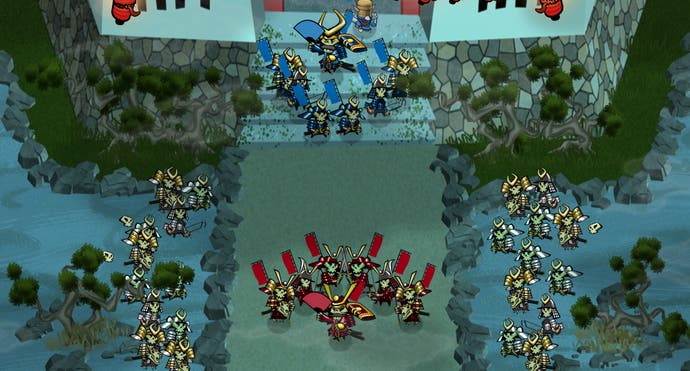
Kazdal's argument is that Skulls is an analogue turn-based game as opposed to Advance Wars' digital model, and that's not better or worse, it's just a little faster and looser. Without the grid - although it's still secretly there to help the AI get around better when it's their turn - you're free to experiment with every single move. If you can get close enough to an enemy to land a blow, it no longer matters if you're facing them directly or if you're off at a weird angle.
I love Advance Wars so much that I kiss a rather tattered picture of Olaf every night before climbing beneath my Medium Tank duvet, but Kazdal's spin on things is rather freeing. Instead of shifting around a series of highlighted squares, Shogun borrows the movement rings of games like Phantom Brave (it also has the same ability to knock enemies to their doom off the edges of a map). Select a unit, and a bold ring appears showing how far it can move. Walk it around a bit, and a second ring opens up inside the first revealing how much movement you'd have left in this turn if you stopped right where you are.
You're encouraged to move, then attack, and then have enough gas left in the tank to make a getaway. Skulls of the Shogun's silent visual prompting genuinely enforces good tactics. Switch to attack, meanwhile, and a red ring appears showing everyone that your unit will definitely be able to hit, while an orange ring hovers just outside of it, displaying the area in which you have a 20 per cent chance of missing. Rings, eh? They're brilliant.
I've rarely understood my tactical options in a game quite so quickly, but my favourite thing about the team's analogue approach is that you can move through your own units, bumping them aside, and allowing them to slip back into place behind you.
"You can walk through your friendlies, so you don't get stuck in those traffic jams that everybody hates," says Kazdal. "One of the first things we wanted to do was get rid of that. But then we bring back that digital element where it's appropriate: you can bring two units together and create something called a spirit wall, that will stop all shots moving through it and hitting someone behind it. Your spirit wall guys will get chewed up, but you could use that kind of tactic to save a weakened general."
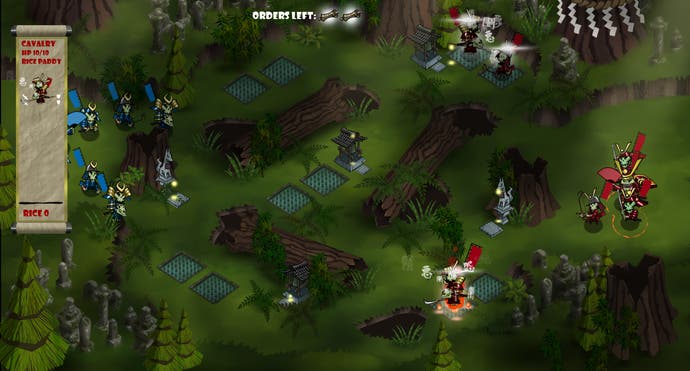
The grid's not the only thing that's missing, of course. Skulls has also done as much as it can to remove menu-surfing, keeping most of the information you'll need within the game world itself and using visual twists as often as numbers. It can be simple stuff, like the fact that the banners each character holds tell you how much life it has left (and, when targeted, how much damage you're likely to do them), or it can cover more complex ideas.
Want to know whether an enemy's likely to counter-attack after a hit? Just move in close and see if they raise their sword or not. There are still stats for each unit if you really want to see them, but Kazdal's confident that he can deliver everything from state changes to attributes in a way that doesn't have you fighting with the interface and ruining the flow of a battle.
Other big changes? Skulls limits things like resources to keep games moving along quickly. "Some of the things I hated were the hamburger grinds," he says. "You have unlimited resources in something like Advance Wars, so everyone keeps earning and fighting until somebody gets a slight advantage, and then it's this slow tidal wave that sweeps across." Instead of the ability to earn endless money from captured cities, each Skulls map comes with a selection of rice paddies for you to harvest. Rice buys you new basic units at the summon shrine, or it can be cashed in to use high-powered spells by monk units. There's always a finite amount on each level, and some maps have very little indeed.
Resource capping cuts down on unit spamming, but even if you do find yourself with dozens of troops, a neat lift from games like Hero Academy means that you can only make five moves per turn anyway, so you're going to have to prioritise which of your guys gets in on the action. "If you have 30 or 40 units in most games, you can move them all, and then everyone else generally has 30 or 40 too," says Kazdal. "Our game is just back and forth, back and forth. It's much faster-paced. It's all going for that arcade thing of, how can we get this game in and going on as soon as possible and then force an end-game?"
The righteous crackdown continues, of course: Skulls also limits the number of types of unit in the game, creating something that feels, at times, a little like Starcraft 2 multiplayer in the process. Alongside your general - the hero unit that you have to keep alive in order to win, and who, once charged up, can attack twice per turn - there are archers who have high attacks but low defences, cavalry that can move a huge distance, and infantry who are tough when taking damage but unspectacular when dealing it. They're all useful in a variety of circumstances and they're all pleasantly easy to understand - and they allow the player room to experiment with the final unit type, the monks, one of whom is unlocked in each of the game's four seasonal acts, granting far more complex powers.
You'll only have one of each monk to mess around with at any time. They're game-changers, in other words, and they require respect and understanding. Take the crow monk, who turns up once the campaign reaches autumn. The crow monk has the power of wind, which sounds pretty exciting, and he'll be used most of the time to push enemies off ledges and generally cause offensive havoc.
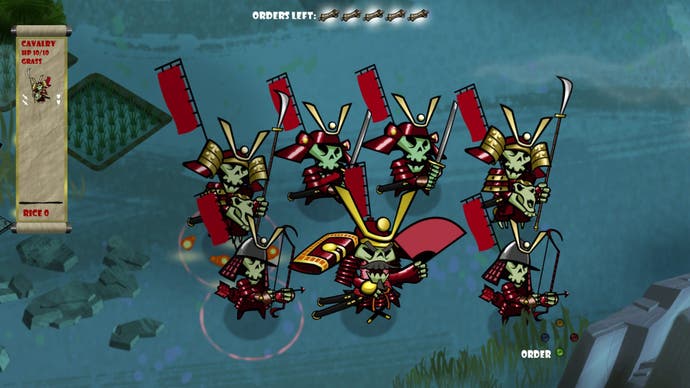
If you're smart, though, you'll also start using him for defensive thinking, as you can use him to nudge your own units back to a safe position once they've used up all of their moves. Power him up properly throughout the course of a level and he becomes really dangerous: he can steal other players' rice, he can provide friendlies with a "miss shield", and he can also enlarge the area and force of his wind powers. (His brother monks seem to be just as rad, BTW.)
If the game's starting to sound a little too pared back, don't fret. Once you're sat in front of it, it's filled with lovely tactical intricacies. The depth fans crave is still there, in fact; it's just arranged so that battles unfold faster. Maps come with turrets that, once captured, will auto-fire on foes and effectively act as control points, and your ability to use monks depend upon holding the shrines that spawned them.
There's bamboo scattered around that allows you to hide your characters, raising the chance that attacks will miss, and you can also power up units by eating the skulls of dead foes. Doing this will grant monks new skills, and it will allow everyone else an additional action for each turn until they die. It's a system that works with the fixed resources to give each mission its own rhythm, in essence. On top of that, loading up on skulls is brilliantly risky, because if you're killed, you drop them all on the spot. "It's not about having two or three really complicated systems," explains 17 Bit co-founder and coder Borut Pfeifer. "You can get a lot of depth by having a lot of really simple systems. That's where you get the emergence aspect."
Aside from the campaign, there's asynchronous multiplayer across platforms - since it's turn-based, the team hasn't had to balance interfaces across controllers and touch screens, although it's worth noting you can use an Xbox controller on tablet - while XBLA players alone will get real-time turn-based multiplayer both locally and online. Whichever format you go for, the lengthy campaign is exactly the same, and there are plenty of multiplayer options to tweak, a good range of map sizes, and the ability to barter with foes and make temporary alliances within the interface. Multiplayer's also been endlessly refined to keep it moving along as fast as the main game, ever since an early session at Kazdal's house concluded when everyone fell asleep between moves.
Skulls is a super exciting prospect, then, both in terms of art and intent, and there's no wonder that, at Rezzed, the queues to play the game wind around the block - or that the community's already pushing Kazdal into creating a crowd-funding campaign to create toys and models. "We've been talking to toy companies for a while," he admits. "But most of them want ten grand up front. We're not that big of a studio. We're basically struggling to stay alive at this point. Someone came up at a show and said, "Why not do a Kickstarter?" and I really think we're going to do that."
When can we all play Skulls of the Shogun? October, allegedly, which sounds so wonderfully appropriate that it has to come to pass. As the evenings draw in and the pumpkins creep out, I'll be right up for staying in with something as fast and as tactical as this. Halloween gaming? All taken care of.


